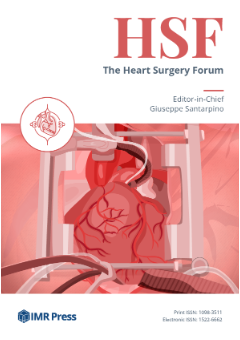Announcements
The Heart Surgery Forum (HSF) is published by IMR Press from Volume 28 Issue 9 (2025). Previous articles were published by another publisher under the CC-BY-NC licence, and they are hosted by IMR Press on imrpress.com as a courtesy and upon agreement.
Open Access
Article
Plasma miRNA-155 Levels Predict Atrial Fibrillation Recurrence after Cardioversion
Show Less
Affiliation
1
Department of Laboratory, the First People’s Hospital of Xianyang City, Xianyang, Shaanxi Province, China
2
Department of Laboratory, the Eighth Hospital of Xi’an City, Xi’an, Shaanxi Province, China
3
Department of Cardiology, the First People’s Hospital of Xianyang, Xianyang, Shaanxi Province, China
Heart Surg. Forum 2019, 22(2),
140–148;
https://doi.org/10.1532/hsf.2281
Published:
11 March 2019
Abstract
Background:MicroRNAs (miRNAs) are widely involved in the regulation of physiological processes, such as cell proliferation, differentiation, apoptosis, angiogenesis, and lipid metabolism. They might be associated with the pathological process of atrial fibrillation (AF). The purpose of our study is to investigate whether plasma miRNA-155 levels have a relationship with AF recurrence.Methods:A total of 110 patients with AF were studied, all with successful cardioversion. We measured the expression of plasma miRNA-155 in the recurrent group (n = 30) and in the nonrecurrent group (n = 80) by quantitative reverse transcription–polymerase chain reaction (qRT-PCR). In addition, the serumal levels of B-type natriuretic peptide (BNP), total cholesterol (TC), and fasting blood glucose (FBG) in the groups were determined by using an automatic biochemical analyzer; and an immunoenzymatic method was applied to determine the serumal levels of tumor necrosis factor-α (TNF-α), C-reactive protein (CRP), and interleukin-6 (IL-6). The left atrial diameter (LAD) and left ventricular ejection fraction (EF) of all patients were measured by using echocardiography.Results:Our RT-PCR analysis found that miRNA-155 was significantly upregulated in the recurrent group compared with the nonrecurrent group. These increases of LAD and the levels of BNP, TNF-α, CRP, and IL-6 in the recurrent group were also revealed to be relative to those in the nonrecurrent group. There were no differences in the levels of TC and FBG, as well as in EF, between the groups. Moreover, miRNA-155 expression was observed to correlate positively with these outcomes of LAD, BNP, TNF-α, CRP, IL-6, and LAD. A diagnostic significance of predicting AF recurrence for plasma miRNA-155 was elucidated via ROC curve analysis.Conclusions:Our findings revealed that plasma miRNA-155 can present an ability to calculate AF recurrence after cardioversion.

